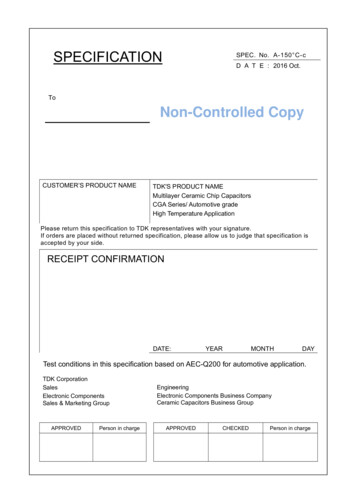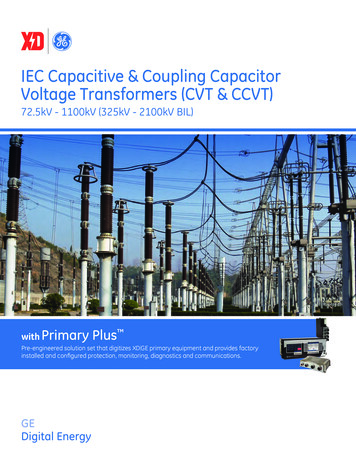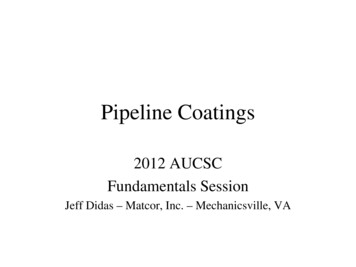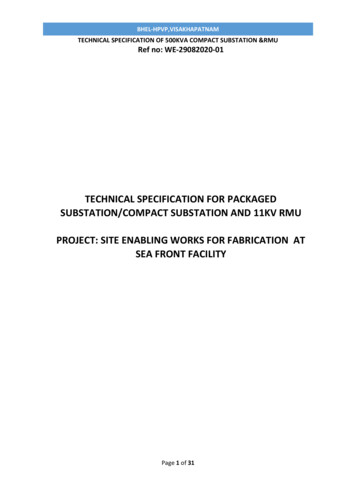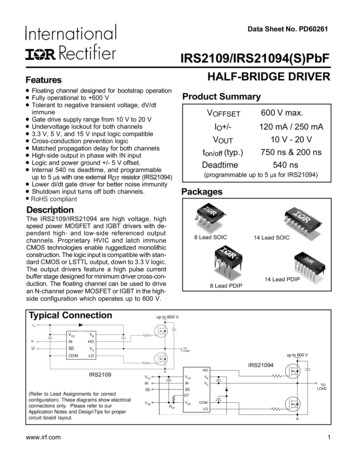
Transcription
Research Articlewww.acsami.orgCoating Solution for High-Voltage Cathode: AlF3 Atomic LayerDeposition for Freestanding LiCoO2 Electrodes with High EnergyDensity and Excellent FlexibilityYun Zhou,† Younghee Lee,‡ Huaxing Sun,‡ Jasmine M. Wallas,‡ Steven M. George,‡ and Ming Xie*,‡,§†College of Chemistry, Chongqing Normal University, Chongqing 401311, ChinaDepartment of Chemistry and Biochemistry, University of Colorado at Boulder, Boulder, Colorado 80309, United States§BattFlex Technologies, Inc., Wuhan 430079, China‡S Supporting Information*ABSTRACT: Freestanding LiCoO2/multiwall carbon nanotube/nanocellulose fibril (LCO-MWCNT-NCF) electrodes arefabricated by a vacuum filtration technique. The electrode has a high LCO loading of 20 mg/cm2 with excellent flexibility,uniform material distribution, and low surface resistivity. When coated with 2 ALD cycles of AlF3, LCO-MWCNT-NCF has ahigh specific capacity of 216 mAh/g at 4.7 V. The freestanding AlF3-coated electrode preserves 75.7% of its initial capacity after100 cycles and 70% after 160 cycles of charge discharge. In contrast, electrodes coated with 2 ALD cycles of Al2O3 cannot becycled above 4.5 V. By elimination of the unnecessary weight of current collector, and increasing in the working voltagesimultaneously, this freestanding LCO-MWCNT-NCF electrode can significantly improve the gravimetric and volumetric energydensity of lithium ion batteries.KEYWORDS: AlF3, atomic layer deposition, freestanding, high energy density, excellent flexibility INTRODUCTIONThe development of flexible electronic devices requiresadvanced lithium ion batteries (LIBs) with significant flexibilityand high energy densities, including specific gravimetric andvolumetric energy densities. There are two common routes toincrease the energy density of a flexible LIB. The first method isto eliminate unnecessary weight, so-called “dead weight”. Thetraditional electrode architecture contains active materials,conductive additives, polymeric binders, and current collectors,the last three of which do not contribute capacity to the battery.Significant efforts have been made to fabricate freestandingelectrodes that do not require current collectors.1 7 In ourprevious study, we successfully developed a freestandingelectrode with an active material mass loading of 40 mg/cm2with only 8% carbon nanotube (CNT).8 This electrodeachieved a specific volumetric energy density of 400 mAh/cm3, the highest reported value in the literature to date.However, CNTs are still very expensive. The CNT content ofcommercial cells is typically less than 2%. Therefore, there is anobvious demand to lower CNT content in freestandingelectrodes in order to realize commercial feasibility. 2017 American Chemical SocietyThe second common method used to increase energy densityis to use high-capacity cathode materials stable at high voltages.Currently, LiCoO2 (LCO) is the most widely used cathodematerial for consumer electronics due to its easy synthesis, highoperating voltage, and high theoretical specific capacity.Recently, significant progress has been made to stabilize LCOat higher voltages, allowing more than 0.5 Li to be extractedduring the charging process.Recently, atomic layer deposition (ALD) has been used as anadvanced coating method for a variety of LIB electrodes.9 12ALD is a coating technique that relies on sequential, selflimiting surface reactions to grow conformal thin films, mosttypically oxides, with angstrom-level thickness control.13 Someof the most striking LIB improvements with ALD have beenachieved with Al2O3 coatings, demonstrating specific capacitiesup to 180 mAh/g when cycled to 4.5 V.8,10,11 However, above4.5 V LCO electrodes show significant performance degradaReceived: December 7, 2016Accepted: February 28, 2017Published: February 28, 20179614DOI: 10.1021/acsami.6b15628ACS Appl. Mater. Interfaces 2017, 9, 9614 9619
Research ArticleACS Applied Materials & InterfacesFigure 1. Schematic illustration of freestanding electrode preparation.a length up to 700 μm. AlF3 and Al2O3 ALD films were grown onfreestanding LCO-MWCNT-NCF electrodes using a hot wall ALDreactor employing static exposures of the reactants.The AlF3 ALD process using TMA and HF derived from HF pyridine solution as precursors was employed for the AlF3 coating onthe electrode:25tion, indicating that Al2O3 is not suitable for voltages higherthan 4.5 V. These metal oxide coatings are susceptible to attackby HF, a common LIB impurity, causing partial conversion ofthe coating to metal fluoride, producing H2O, and effectinglong-term cycling stability.14 16 While ALD metal oxidecoatings have contributed greatly to the enhancement ofLIBs, the observed maximum voltage limit and the HFreactivity restrict the overall effectiveness of these coatings.Therefore, ALD coatings on electrodes that can enable highervoltage limits and do not exhibit reaction with HF are needed.AlF3 has shown promise as a protective electrode coating inLIBs.17,18 Coatings of AlF3, a wide band gap ( 10 eV)material,19,20 have been studied on both cathodes and anodes,demonstrating increased cycling stability.17,18,21 Additionally,AlF3 coatings may improve the thermal properties of cathodesby suppressing oxygen evolution at elevated temperatures.22Studies of AlF3 ALD coatings on battery electrodes have beenlimited. Jackson et al. studied AlF3 ALD deposited with TMAand TaF5 as an electrode coating; however, their films had highimpurity levels ( 4%) and capacities well below those seen inAl2O3-ALD-coated electrodes.23 J. S. Park et al.24 reportedaluminum tungsten fluoride (AlWxFy) films on LCO electrodes by ALD using TMA and tungsten hexafluoride (WF6).Again, these ALD films did not exceed the performance ofAl2O3 ALD coatings, with a maximum voltage of 4.4 V.Recently, Y. Lee et al.25 reported a facile and low-impurity( 2%) AlF3 ALD using trimethylaluminum (TMA) and HFfrom an HF pyridine solution. This AlF3 ALD coating ispromising as an electrode protector, potentially allowing highervoltage ranges and higher energy densitites. To our knowledge,no other study has used this ALD method for battery coatingstudies.In this work, we fabricated a freestanding LCO-MWCNTNCF (LiCoO2/multiwall carbon nanotube/nanocellulosefibrils) electrode with 2% of CNT and 5% of NCF. We thencoated freestanding electrodes with AlF3 ALD using the ALDsystem described by Y. Lee et al.25 Several thicknesses of AlF3coatings were investigated to optimize LIB performance. Thehighest capacity observed in this study was 216 mAh/g at 4.7 Vwith a coating of 2 ALD cycles of AlF3, corresponding to avolumetric density of 720 mAh/cm3. After 100 cycles, theelectrode still maintains 75.7% of its initial capacity after 100cycles and 70% after 160 cycles at 4.7 V, indicating excellentcycling stability. AlF3 HF* Al(CH3)3 AlF3 AlF(CH3)2 * CH4(A)AlF(CH3)2 * HF AlF3 HF* CH4(B)For the AlF3 ALD, TMA (97%) and HF pyridine (70 wt % HF) wereobtained from Sigma-Aldrich.The AlF3 ALD reaction sequence follows: (i) dose TMA to 2.0Torr; (ii) hold TMA pressure static for 30 s; (iii) evacuate reactionproducts and excess TMA for 60 s; (iv) flow 50 sccm N2 for 360 s; (v)evacuate N2 for 60 s; (vi) dose HF to 1.0 Torr; (vii) hold HF pressurestatic for 30 s; (viii) evacuate reaction products and excess HF for 60 s;(ix) flow 50 sccm N2 for 360 s; (x) evacuate N2 for 60 s. This sequenceconstitutes one cycle of AlF3 ALD. This AlF3 ALD was conducted at150 C.An Al2O3 ALD process utilizing trimethylaluminum (TMA) andH2O as precursors26 was employed for Al2O3 coating on electrode.AlOH* Al(CH3)3 AlO Al(CH3)2 * CH4(C)AlCH3* H 2O AlOH CH4(D)Al2O3 ALD used the same conditions except with H2O instead of HF.The electrodes were punched off from a 13 cm 13 cmfreestanding electrode, and then pressed to different thicknesses by aroll presser. All of the coin cells were assembled in an argon-filledglovebox with Li metal as the counter electrode. A Celgard separator2340 and 1 M LiPF6 electrolyte solution in 1:1 w/w ethylenecarbonate/diethyl carbonate (Novolyte) were used. The galvanostaticcharge/discharge characteristics were analyzed using an Arbin BT2143 Battery Station. RESULTS AND DISCUSSIONFreestanding electrodes were made using vacuum filtration withLCO particles as active material, 2% of MWCNTs asconductive additive, and 5% NCF as binder. A fabricationscheme is shown in Figure 1, and a more detailed description ofthe fabrication procedure can be found in previouspublications.2 5,8,27 29 The freestanding electrode used in thispaper is 13 cm 13 cm (Figure 2a), though vacuum filtrationfabrication confers easy scale-up. The whole filtration timetakes about 2 min. Without NCF, LCO with 2% MWCNTcannot be peeled off of the filtration membrane without massloss due to the weak mechanical strength. When CNT contentis increased to 8%, it is easy to peel off the electrode as awhole;8 however, the cost is prohibitive. When 5% NCF isadded with 2% CNTs, no residue is seen on the surface of thefiltration membrane due to the strong hydrogen bond amongnanocellulose fibers. This electrode is flexible enough to beEXPERIMENTAL DETAILSLCO was used as received from Sigma-Aldrich (99.8% trace metalsbasis). MWCNTs were purchased from NanoTechLabs Inc. with alarge aspect ratio 104. NCF was purchased from NingBo ATMKLithium Ion Technologies, Inc. It has a small diameter of 50 nm and9615DOI: 10.1021/acsami.6b15628ACS Appl. Mater. Interfaces 2017, 9, 9614 9619
Research ArticleACS Applied Materials & InterfacesFigure 2. (a) A 13 cm by 13 cm freestanding paper electrode; (b)paper electrode that can be readily rolled; (c, d) SEM images of LCOuniformly embedded in a MWCNT matrix before and aftercompression.Figure 3. (a) XPS surface scan of an LCO-MWCNT electrode coatedwith 2 ALD cycles of AlF3; (b) the XPS spectrum of the Al 2p peak;(c) the XPS spectrum of the F 1s peak.interaction between the AlF3 film and moisture. Figure 3cshows the XPS spectrum of the F 1s peak at 685.2 eV. The F 1speak at a higher binding energy of 685.2 eV is consistent withthe F 1s peak at 685.2 eV observed in an 82 nm thick AlF3 ALDfilm. The additional F 1s peak at a lower binding energy of682.2 eV may be attributed to the Co F or Li F bondsresulting from the reaction of HF with LCO during the AlF3ALD film growth. These Al and F XPS signals from the AlF3coating increased due to the increased thickness of the AlF3coating.LCO-MWCNT-NCF coated with 2 cycles of Al2O3 is testedunder 1 C rate at 4.6 and 4.7 V, respectively, in Figure 4. Figureeasily rolled onto a pencil, as shown in Figure 2b. The scanningelectron microscopy (SEM) images before and aftercompression (Figure 2c,d) show the uniform distribution ofLCO particles in the continuous MWCNT and fibrillatednanocellulose network and the well-developed porous structureof the composite cathode. In Figure 2c, LCO particles areloosely tangled with MWCNTs and NCF, presenting anabundance of mesopores. After compression, the electrodethickness is greatly reduced from 220 to 60 μm, and LCO hasmuch more contact with MWCNT and NCF. This correspondsto a compact density of 3.33 g/cm3, slightly lower than thatused in commercial products around 3.8 4.0 g/cm3, but muchhigher than all of the freestanding electrodes previouslypublished.1 5,30 A low surface resistance of 5Ω/ withonly 8 wt % of MWCNTs is observed after compression,compared to 50 Ω/ before compression. With 2% CNTand 5% NCF, the surface resistance reduces from 100 Ω/ before compression to 30 Ω/ after compression. Thisdifference may deteriorate the electrode’s C-rate capability.We also noticed that the thickness and surface resistanceuniformity of freestanding electrodes are greatly improved to 5% after compression.AlF3 ALD coatings on LCO-MWCNT electrodes weredeposited in a hot wall reactor.25 Al2O3 ALD coatings were alsodeposited in the same reactor. XPS analysis was performed toconfirm the exsistence of the AlF3 coating on the LCOMWCNT electrodes. Figure 3a shows an XPS surface scan ofan LCO-MWCNT electrode coated with 2 ALD cycles of AlF3.XPS signals of C, O, F, Al, Co are observed with atomicpercentages of 61.9, 24.4, 9.4, 4.1, and 0.3, respectively. The Cpeak arises from both carbon in the MWCNT and adventitiouscarbon. The Al and F peaks are assigned to the AlF3 ALDcoating. The Co peak is assigned to LCO. Figure 3b shows theXPS spectrum of the Al 2p peak located at 75.2 eV. The peakposition consists of a main peak at 75.2 eV and a small peak at73.2 eV. The Al 2p peak at the higher binding energy of 75.2 eVis in good agreement with the Al 2p peak at 74.80 eV obtainedfrom an 82 nm AlF3 film grown on Si with similar conditions.The additional Al 2p peak at a lower binding energy of 73.2 eVmay be attributed to the Al O bond resulting from theFigure 4. LCO-MWCNT coated with 2 cycles of Al2O3 is tested under1 C rate at (a) 4.6 V and (b) 4.7 V; LCO-MWCNT coated with 2cycles of AlF3 is tested under 1 C rate at (c) 4.5 V and (d) 4.7 V. 1 C 160 mA/g.4a shows dramatic capacity loss of 82% of its initial capacityafter 100 cycles at 4.6 V, and Figure 4b shows an even fasterdrop at 4.7 V. In our prevous work,8 LCO-MWCNT-NCF with2 cycles of Al2O3 still preserves 95% of its initial capacity after85 cycles at 4.5 V. This indicates that the Al2O3 coatingprovides limited protection on LCO-MWCNT-NCF up to 4.5V. Above 4.5 V, the Al2O3 coating either reacts severely withHF in the electrolyte or the organic electrolyte decomposes9616DOI: 10.1021/acsami.6b15628ACS Appl. Mater. Interfaces 2017, 9, 9614 9619
Research ArticleACS Applied Materials & Interfacesrapidly and forms a thick insulating film on the surface of LCOMWCNT, preventing lithium ion diffusion.In comparison to the Al2O3 coating, a coating of 2 cycles ofAlF3 on LCO-MWCNT-NCF shows a great improvement at4.7 V. At 4.5 V, AlF3 shows cycling performance stabilitycomparable to that of Al2O3 in Figure 4c. When the uppervoltage limit is increased to 4.7 V, AlF3-coated LCO-MWCNTNCF preserves 75.7% of its initial capacity after 100 cycles and70% after 160 cycles at a rate of 0.5 C, as shown in Figure 4d.We would like to point out that the electrolyte used in thiswork is not designed for voltages above 4.5 V. The initialcoulombic efficiency (CE) is 91.6%, and soon improves toabove 99% after 5 cycles. In order to achieve 80% capacityretention after 400 cycles, CE should reach above 99.95%.Adding high-voltage additives should reduce electrolytedecomposition and further improve CE and cycling performance. The significant enhancement in capacity retention of AlF3at 4.7 V is likely due to increased HF resistance and stability athigh voltage. AlF3 has a lower Gibbs free energy than that ofAl2O3,31 which indicates intrinsically more stable nature. AlF3can also effectively suppress the fast growth of the solidelectrolyte interphase film upon cycling.32 The half-cell wasdisassembled after cycling, and no crack or electrode peelingwas observed, indicating the excellent mechanical stability ofthe freestanding electrode. The surface of LCO after cycling isshown in SI Figure 1. No significant surface coating is observedcompared to Figure 2d.A flexible pouch cell was assembled with freestanding LCOMWCNT-NCF as cathode and graphite/MWCNT-NCF asanode. The mass loadings of LCO and graphite were 20 and 10mg/cm2, respectively. Two pairs of electrodes were used. Avideo showing that the battery delivers a stable output voltagewhile bending can be found in SI.The charge discharge voltage profiles of AlF3-ALD-coatedLCO-MWCNT-NCF at 4.7 V are shown in Figure 5. TheIn order to study the optimum AlF3 coating thickness,freestanding LCO-MWCNT-NCF electrodes coated with 2, 5,and 8 cycles of AlF3 were tested under a 1 C rate shown inFigure 6. The voltage increases sequentially from 4.3 to 4.5, 4.6,Figure 5. Charge discharge voltage profile of LCO-MWCNT coatedwith 2 cycles of AlF3 from 3.3 to 4.7 V. The current density is 0.5 C.Figure 6. Freestanding LCO-MWCNT electrodes coated with (a) 2,(b) 5, and (c) 8 cycles of AlF3 were tested under a 1 C rate. Thevoltage increases sequentially from 4.3 to 4.5, 4.6, and 4.7 V.discharge curve of AlF3-coated LCO-MWCNT displays a widepotential plateau near 3.9 V due to the coexistence of twopseudophases of a Li-dilute α-phase and a Li-concentrated βphase.33 LCO-MWCNT with 2 cycles of AlF3 has a highspecific capacity of 216 mAh/g at 4.7 V, and a correspondingvolumetric energy density of 720 mAh/cm3. The gravimetricand volumetric energy densities of the freestanding electrodesare 18% and 21% higher, respectively, than an electrode withthe same mass loading and a 16 μm Al current collector. Thatimprovement can be even more profound for the anode due tothe high density of Cu current collectors. By eliminatingcurrent collectors and increasing the charging voltage, one cansignificantly improve the energy density of batteries.and 4.7 V. In Figure 6a, LCO-MWCNT-NCF with 2 cycles ofAlF3 displays the highest capacity at all voltages, While LCOMWCNT-NCF with 8 cycles of AlF3 has the lowest, shownFigure 6c. Although the 5 cycle AlF3-coated electrode has alimited capacity of 160 mAh/g at 4.7 V, it shows very stablecycling after 4.5 and 4.6 V for 10 cycles of charge/discharge.High-voltage stability of AlF3 may be due to its larger band gap(10 eV for AlF3 vs 6.2 eV for Al2O3).19,20,34 As the thickness ofthe AlF3 coating is increased, more energy is required to drivelithium ions across it. Therefore, we conclude that 2 cycles ofAlF3 strikes the balance between high-voltage protection andcapacity realization.9617DOI: 10.1021/acsami.6b15628ACS Appl. Mater. Interfaces 2017, 9, 9614 9619
ACS Applied Materials & Interfaces CONCLUSIONSA 13 cm 13 cm freestanding LCO-MWCNT-NCF paperelectrode with high areal mass loading was fabricated byvacuum filtration. The electrode has a low CNT content of 2%,with 5% NCF, and a high LCO mass loading of 20 mg/cm2. Inaddition, the electrode has excellent flexibility, uniform materialdistribution, and low surface resistivity. LCO particles areuniformly archored within a continuous three-dimensionalconducting MWCNT and NCF matrix with significantmesoporous structure. After compression, LCO has betterelectrical contact with MWCNT and NCF and a reduced poresize. When coated with 2 cycles of Al2O3 by ALD, LCOMWCNT-NCF cannot sustain cycling stability above 4.5 V andloses 82% of its initial capacity in the first 100 cycles at 4.6 V.When coated with 2 cycles of AlF3 by ALD, LCO-MWCNTNCF preserves 75.7% of its initial capacity after 100 cycles and70% after 160 cycles at 4.7 V. This high capacity retentionindicates that AlF3 ALD coatings create exceptional highvoltage protection on cathodes, and deserve further explorationas battery coatings. The freestanding AlF3-coated LCOMWCNT-NCF electrode has a high capacity of 216 mAh/gat 4.7 V, and a correspondingly high volumetric energy densityof 720 mAh/cm3. With the combined effect of eliminatingunnecessary weight and volume, and increasing chargingvoltage to offer more capacity, this freestanding electrode hasan 18% higher gravimetric and 21% higher volumetric energydensity than conventional electrodes with Al current collectors.To the best of our knowledge, our freestanding electrodes havethe highest energy density in the literature, indicating greatpotential for flexible batteries with high energy density.Continuous production of a freestanding electrode is currentlyunder study by BattFlex Technologies, Inc. REFERENCES(1) Hu, L.; La Mantia, F.; Wu, H.; Xie, X.; McDonough, J.; Pasta, M.;Cui, Y. Lithium-Ion Textile Batteries with Large Areal Mass Loading.Adv. Energy Mater. 2011, 1 (6), 1012 1017.(2) Fang, X.; Ge, M. Y.; Rong, J. P.; Zhou, C. W. Free-StandingLiNi0.5Mn1.5O4/Carbon Nanofiber Network Film as Lightweightand High-Power Cathode for Lithium Ion Batteries. ACS Nano 2014,8 (5), 4876 4882.(3) Choi, K.-H.; Cho, S.-J.; Chun, S.-J.; Yoo, J. T.; Lee, C. K.; Kim,W.; Wu, Q.; Park, S.-B.; Choi, D.-H.; Lee, S.-Y.; Lee, S.-Y.Heterolayered, One-Dimensional Nanobuilding Block Mat Batteries.Nano Lett. 2014, 14 (10), 5677 5686.(4) Ban, C. M.; Li, Z.; Wu, Z. C.; Kirkham, M. J.; Chen, L.; Jung, Y.S.; Payzant, E. A.; Yan, Y. F.; Whittingham, M. S.; Dillon, A. C.Extremely Durable High-Rate Capability of a LiNi0.4Mn0.4Co0.2O2Cathode Enabled with Single-Walled Carbon Nanotubes. Adv. EnergyMater. 2011, 1 (1), 58 62.(5) Luo, S.; Wang, K.; Wang, J. P.; Jiang, K. L.; Li, Q. Q.; Fan, S. S.Binder-Free LiCoO2/Carbon Nanotube Cathodes for High-Performance Lithium Ion Batteries. Adv. Mater. 2012, 24 (17), 2294 2298.(6) Deng, X.; Xie, K.; Li, L.; Zhou, W.; Sunarso, J.; Shao, Z. Scalablesynthesis of self-standing sulfur-doped flexible graphene films asrecyclable anode materials for low-cost sodium-ion batteries. Carbon2016, 107, 67 73.(7) Chu, S.; Zhong, Y.; Cai, R.; Zhang, Z.; Wei, S.; Shao, Z.Mesoporous and Nanostructured TiO2 layer with Ultra-High Loadingon Nitrogen-Doped Carbon Foams as Flexible and Free-StandingElectrodes for Lithium-Ion Batteries. Small 2016, 12 (48), 6724 6734.(8) Xie, M.; Li, B.; Zhou, Y. Free-standing high-voltage LiCoO2/multi-wall carbon nanotube paper electrodes with extremely high arealmass loading for lithium ion batteries. J. Mater. Chem. A 2015, 3 (46),23180 23184.(9) Guan, D.; Jeevarajan, J. A.; Wang, Y. Enhanced cycleability ofLiMn2O4 cathodes by atomic layer deposition of nanosized-thinAl2O3 coatings. Nanoscale 2011, 3 (4), 1465 1469.(10) Jung, Y. S.; Cavanagh, A. S.; Dillon, A. C.; Groner, M. D.;George, S. M.; Lee, S.-H. Enhanced Stability of LiCoO2 Cathodes inLithium-Ion Batteries Using Surface Modification by Atomic LayerDeposition. J. Electrochem. Soc. 2010, 157 (1), A75 A81.(11) Scott, I. D.; Jung, Y. S.; Cavanagh, A. S.; Yan, Y.; Dillon, A. C.;George, S. M.; Lee, S.-H. Ultrathin Coatings on Nano-LiCoO2 for LiIon Vehicular Applications. Nano Lett. 2011, 11 (2), 414 418.(12) Zhao, J.; Wang, Y. Ultrathin Surface Coatings for ImprovedElectrochemical Performance of Lithium Ion Battery Electrodes atElevated Temperature. J. Phys. Chem. C 2012, 116 (22), 11867 11876.(13) George, S. M. Atomic Layer Deposition: An Overview. Chem.Rev. 2010, 110 (1), 111 131.(14) Sun, Y.-K.; Cho, S.-W.; Lee, S.-W.; Yoon, C. S.; Amine, K. AlF3Coating to Improve High Voltage Cycling Performance of Li [Ni1/3Co1/3Mn1/3]O2 Cathode Materials for Lithium SecondaryBatteries. J. Electrochem. Soc. 2007, 154 (3), A168 A172.(15) Myung, S.-T.; Izumi, K.; Komaba, S.; Sun, Y.-K.; Yashiro, H.;Kumagai, N. Role of Alumina Coating on Li Ni Co Mn OParticles as Positive Electrode Material for Lithium-Ion Batteries.Chem. Mater. 2005, 17 (14), 3695 3704.(16) Kim, J. W.; Kim, D. H.; Oh, D. Y.; Lee, H.; Kim, J. H.; Lee, J. H.;Jung, Y. S. Surface chemistry of LiNi0.5Mn1.5O4 particles coated byAl2O3 using atomic layer deposition for lithium-ion batteries. J. PowerSources 2015, 274, 1254 1262.(17) Sun, Y. K.; Lee, M. J.; Yoon, C. S.; Hassoun, J.; Amine, K.;Scrosati, B. The Role of AlF3 Coatings in Improving ElectrochemicalCycling of Li-Enriched Nickel-Manganese Oxide Electrodes for Li-IonBatteries. Adv. Mater. 2012, 24 (9), 1192 1196.(18) Ding, F.; Xu, W.; Choi, D. W.; Wang, W.; Li, X. L.; Engelhard,M. H.; Chen, X. L.; Yang, Z. G.; Zhang, J. G. Enhanced Performanceof Graphite Anode Materials by AlF3 Coating for Lithium-IonBatteries. J. Mater. Chem. 2012, 22 (25), 12745 12751.ASSOCIATED CONTENTS Supporting Information*The Supporting Information is available free of charge on theACS Publications website at DOI: 10.1021/acsami.6b15628.Images of relevant samples (PDF)Video showing that the battery delivers a stableoutput voltage while bending (MP4) Research ArticleAUTHOR INFORMATIONCorresponding Author*E-mail: ming.xie@battflex.com.ORCIDYun Zhou: 0000-0003-3926-9405Steven M. George: 0000-0003-0253-9184NotesThe authors declare no competing financial interest. ACKNOWLEDGMENTSThe work at Chongqing Normal University was supported bythe Natural Science Foundation of China (21301199), NaturalScience Foundation of Chongqing Municipality (cstc2014jcyjA50035), and Chongqing Municipal Education Commission(KJ130601). Work at BattFlex Technologies Inc. was supportedby the 3551 Recruitment Program of Global Experts by WuhanEast Lake Hi-Tech Development Zone, China. The work doneat the University of Colorado, Boulder was supported by theDefense Advanced Research Project Agency (DARPA).9618DOI: 10.1021/acsami.6b15628ACS Appl. Mater. Interfaces 2017, 9, 9614 9619
Research ArticleACS Applied Materials & Interfaces(19) Barriere, A. S.; Lachter, A. Optical-Transitions in DisorderedThin-Films of Ionic Compounds MgF2 and AlF3 as a Function ofTheir Conditions of Preparation. Appl. Opt. 1977, 16 (11), 2865 2871.(20) Konig, D.; Scholz, R.; Zahn, D. R. T.; Ebest, G. Band Diagramof the AlF3/SiO2/Si System. J. Appl. Phys. 2005, 97 (9), 093707.(21) Zheng, J. M.; Zhang, Z. R.; Wu, X. B.; Dong, Z. X.; Zhu, Z.;Yang, Y. The Effects of AlF3 Coating on the Performance ofLi[Li0.2Mn0.54Ni0.13Co0.13]O2 Positive Electrode Material for LithiumIon Battery. J. Electrochem. Soc. 2008, 155 (10), A775 A782.(22) Myung, S. T.; Lee, K. S.; Yoon, C. S.; Sun, Y. K.; Amine, K.;Yashiro, H. Effect of AlF3 Coating on Thermal Behavior of ChemicallyDelithiated Li0.35[Ni1/3Co1/3Mn1/3]O2. J. Phys. Chem. C 2010, 114(10), 4710 4718.(23) Jackson, D. H. K.; Laskar, M. R.; Fang, S.; Xu, S.; Ellis, R. G.; Li,X.; Dreibelbis, M.; Babcock, S. E.; Mahanthappa, M. K.; Morgan, D.;Hamers, R. J.; Kuech, T. F. Optimizing AlF3 atomic layer depositionusing trimethylaluminum and TaF5: Application to high voltage Li-ionbattery cathodes. J. Vac. Sci. Technol., A 2016, 34 (3), 031503.(24) Park, J. S.; Mane, A. U.; Elam, J. W.; Croy, J. R. AmorphousMetal Fluoride Passivation Coatings Prepared by Atomic LayerDeposition on LiCoO2 for Li-Ion Batteries. Chem. Mater. 2015, 27(6), 1917 1920.(25) Lee, Y.; DuMont, J. W.; Cavanagh, A. S.; George, S. M. AtomicLayer Deposition of AlF3 Using Trimethylaluminum and HydrogenFluoride. J. Phys. Chem. C 2015, 119 (25), 14185 14194.(26) Dillon, A. C.; Ott, A. W.; Way, J. D.; George, S. M. Surfacechemistry of Al2O3 deposition using Al(CH3)3 and H2O in a binaryreaction sequence. Surf. Sci. 1995, 322 (1 3), 230 242.(27) Jabbour, L.; Bongiovanni, R.; Chaussy, D.; Gerbaldi, C.;Beneventi, D. Cellulose-based Li-ion batteries: a review. Cellulose2013, 20 (4), 1523 1545.(28) Jabbour, L.; Destro, M.; Chaussy, D.; Gerbaldi, C.; Penazzi, N.;Bodoardo, S.; Beneventi, D. Flexible cellulose/LiFePO4 papercathodes: toward eco-friendly all-paper Li-ion batteries. Cellulose2013, 20 (1), 571 582.(29) Lu, H.; Behm, M.; Leijonmarck, S.; Lindbergh, G.; Cornell, A.Flexible Paper Electrodes for Li-Ion Batteries Using Low Amount ofTEMPO-Oxidized Cellulose Nanofibrils as Binder. ACS Appl. Mater.Interfaces 2016, 8 (28), 18097 18106.(30) Wu, Z. Z.; Han, X. G.; Zheng, J. X.; Wei, Y.; Qiao, R. M.; Shen,F.; Dai, J. Q.; Hu, L. B.; Xu, K.; Lin, Y.; Yang, W. L.; Pan, F.Depolarized and Fully Active Cathode Based on Li(Ni0.5Co0.2Mn0.3)O-2 Embedded in Carbon Nanotube Networkfor Advanced Batteries. Nano Lett. 2014, 14 (8), 4700 4706.(31) Sun, Y.-K.; Lee, M.-J.; Yoon, C. S.; Hassoun, J.; Amine, K.;Scrosati, B. The Role of AlF3 Coatings in Improving ElectrochemicalCycling of Li-Enriched Nickel-Manganese Oxide Electrodes for Li-IonBatteries. Adv. Mater. 2012, 24 (9), 1192 1196.(32) Sun, S. W.; Yin, Y. F.; Wan, N.; Wu, Q.; Zhang, X. P.; Pan, D.;Bai, Y.; Lu, X. AlF3 Surface-Coated Li[Li0.2Ni0.17Co0.07Mn0.56]O-2Nanoparticles with Superior Electrochemical Performance forLithium-Ion Batteries. ChemSusChem 2015, 8 (15), 2544 2550.(33) Choi, Y.-M.; Pyun, S.-I.; Bae, J.-S.; Moon, S.-I. Effects of lithiumcontent on the electrochemical lithium intercalation reaction intoLiNiO2 and LiCoO2 electrodes. J. Power Sources 1995, 56 (1), 25 30.(34) Afanas’ev, V. V.; Houssa, M.; Stesmans, A.; Heyns, M. M. Bandalignments in metal oxide silicon structures with atomic-layerdeposited Al2O3 and ZrO2. J. Appl. Phys. 2002, 91 (5), 3079 3084.9619DOI: 10.1021/acsami.6b15628ACS Appl. Mater. Interfaces 2017, 9, 9614 9619
In this work, we fabricated a freestanding LCO-MWCNT-NCF (LiCoO 2 /multiwall carbon nanotube/nanocellulose fibrils) electrode with 2% of CNT and 5% of NCF. We then coated freestanding electrodes with AlF 3 ALD using the ALD system described by Y. Lee et al.25 Several thicknesses of AlF 3 coatings were investigated to optimize LIB performance. The

